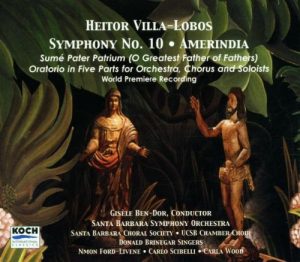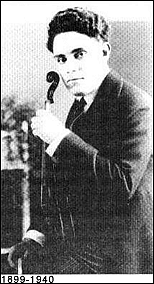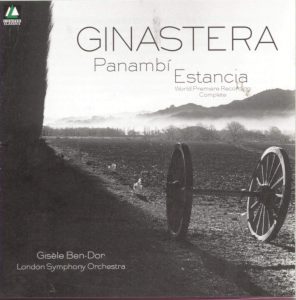Amazon.com
By Paul Cook
 “This is a world-premiere recording that’s coifed rather lovingly by conductor Gisèle Ben-Dor, and is a must for fans of Villa-Lobos.”
“This is a world-premiere recording that’s coifed rather lovingly by conductor Gisèle Ben-Dor, and is a must for fans of Villa-Lobos.”
Heitor Villa-Lobos (1887-1959) was one of the more prolific composers of the 20th century. He wrote 12 symphonies, of which the Fifth is lost, and composed in every possible musical mode there is, including a Broadway musical and film music. Villa-Lobos’s Tenth Symphony (1957) is a grand-scale choral work in a “mixed-language” format. It’s meant to celebrate the founding of São Paulo, Brazil, and includes Indian texts, as well as Latin verse that is sung by soloists and choir. All of Villa-Lobos’s contrapuntal “bachian” rhythms are here, including his distinct brand of lyrical romanticism. The work is celebratory, opulent, and colorful; the studio sound full-bodied and rich. This is a world-premiere recording that’s coifed rather lovingly by conductor Gisèle Ben-Dor, and is a must for fans of Villa-Lobos.
Classicstoday.com
By David Hurwitz
Heitor Villa-Lobos’ Tenth Symphony commemorates the founding of the city of São Paulo, not exactly an event of special international musical significance. Nor does the text, an ambitious combination of three languages (Tupí, Portuguese, and Latin), two religions (pagan and Christian), and a politically correct (for the time and occasion) triumphant optimism, offer many obvious opportunities to garner broader appeal for the work. There are basically two approaches a composer can take when faced with this sort of project: they can write crap (as for example Shostakovich did in his Twelfth Symphony), or they can forget about the banality of the initial circumstances of performance and write the best music they know how anyway (as in Beethoven’s Consecration of the House Overture). Villa-Lobos follows Beethoven’s path. This is vintage stuff. The opening prelude portrays a sort of jungle chaos before the creation of mankind as only the great Brazilian composer can: wild string writing, soulful melodies in strange places (trombones especially), thudding percussion–my god, but this is fun! The vocal sections show no less aural imagination. The chorus and soloists sing, hum, and chant in every conceivable combination: men alone, women alone, solos individually and with chorus, you name it. The result is so interesting and inventive that it really doesn’t matter at all what they’re singing about.
“In short, the work is a masterpiece, and no praise can be high enough for what conductor Gisèle Ben-Dor and her Santa Barbara forces have done in bringing it to life… the result, a labor of love, sounds magnificent. Ben-Dor has her orchestra playing with confidence and tremendous gusto”
And then, to top it all off, the text on closer examination turns out to be not that bad. The composer himself assembled it from a variety of sources, primarily a huge Marian poem by missionary priest José de Anchieta, and the word setting is as sensitive as the language is vivid. In short, the work is a masterpiece, and no praise can be high enough for what conductor Gisèle Ben-Dor and her Santa Barbara forces have done in bringing it to life. Putting together a project of this size is difficult enough, but in this case the original score and parts had to be located and corrected, necessitating a vast amount of pre-performance editorial work. The result, a labor of love, sounds magnificent. Ben-Dor has her orchestra playing with confidence and tremendous gusto, and the various choruses and soloists cope impressively with what sounds like excruciatingly difficult (or at all events exposed) vocal writing. The recorded sound offers both opulence and excellent balances. If you like Villa-Lobos, you will love this; if you fancy a change from yet another Carmina Burana or choral favorite, give this a shot. You won’t be sorry.
Recordsinternational.com
“this is an orgy of sound, color and rhythm which will delight any hedonist.”
HEITOR VILLA-LOBOS (1887-1959): Symphony No. 10 “Amerindia”. Well, it’s everything you’d expect: massed vocal, choral and orchestral forces pounding out Afro-Indian rhythms, a riot of instrumental color and orchestral virtuosity which ultimately leaves the listener shaking his head and wondering what train just hit him. Composed for the 400th anniversary of the founding of São Paulo in 1952, the work only received its premiere in Paris in 1957. More oratorio than abstract symphony, the pieces uses texts by a 16th-century Jesuit missionary which Villa-Lobos sets in the native Tupí language, Latin and Portuguese. Similarly, he uses three musical styles: the native population is represented by long, ongoing melodies with many repeated intervals, the tonally ambiguous music of the Portuguese – the outsiders who force change and adaptation – and the syncopations and cross-rhythms of the resulting Afro-Brazilian population. The orchestra is huge, including quadruple brass, triple woodwinds, a very large percussion section, piano and organ. The five movements are titled “The Earth and its Creatures”; “War Cry”; “Iurupichuna” (a species of magical monkey) and two others whose length would use up the rest of this page. Suffice it to say that this is an orgy of sound, color and rhythm which will delight any hedonist. Tupí/Latin/Portuguese – English texts. Carla Wood (mezzo), Carlo Scibelli (tenor), Nmon Ford-Levine (bass-baritone), Donald Brinegar Singers, USCB Chamber Choir, Santa Barbara Choral Society, Santa Barbara Symphony Orchestra; Gisèle Ben-Dor. Koch International Classics 3-7488-2 (U.S.A.) 10C001 $16.98
Classicalcdreview.com
By Ken Sanson
Ask any dedicated concertgoer or CD connoisseur to name one composition composed by Brazil’s most famous composer, Heitor Villa-Lobos (1887-1959), and chances are the answer would be “Bachiana brasileira No. 5” for solo soprano and 8 cellos. What about a Villa-Lobos symphony? Not likely. Even music critics, orchestral conductors , and professional musicians probably would not know of his 12 symphonies (No. 5 is lost) much less heard or performed them.
“music which is basic, direct and very involving. And meaningful… especially recommended for those wanting to be surrounded by sumptuous orchestral sounds.”
Adding to previously-released CDs of the 4th and 6th symphonies is this new (and world premiere) recording of his Symphony No. 10 subtitled “Amerindia,” with soloists, choruses and the Santa Barbara (Calif) Symphony Orchestra conducted by Gisèle Ben-Dor.
The symphony, composed to honor the 400th anniversary of the founding of São Paulo in 1952 (but premiered five years later in Paris on April 4, 1957), is described by the composer as an “oratorio in five parts for orchestra, chorus and soloists.” (The program notes call it a five-movement “symphony” when analyzing it.). Whatever, this oratorio/symphony traces the history of São Paulo from writings by Father José de Anchieta , a Jesuit priest and missionary to Brazil. The text incorporates three different languages: the native Tupí, Latin, representing the missionaries, and Portuguese, the European settlers.
In like manner, Villa-Lobos matches (or accommodates) the music to enhance the text-long, chant-like and often repeated melodies (native Indians), angular and tonally-obscure music (Portuguese), and imaginative polyrhythms (Afro-Brazilians).
All that background information is far more technical (overkill comes to mind) than the music which is basic, direct and very involving. And meaningful. Subdued unisons suddenly burst into 8-part tone clusters. And the same textural expansions are featured in Villa-Lobos’ rich orchestration, which encompasses a wide range of interesting colors and rhythms. In fact, with all due respect to the soloists and choruses, the main interest lies in the orchestral score.
Solid performances throughout by vocal soloists Nmon Ford-Livene, Carlo Scibelli, Carla Wood, the Santa Barbara Choral Society, UCSB Chamber Choir, Donald Brinegar Singers, and the orchestra conducted by Gisèle Ben-Dor. Especially recommended for those wanting to be surrounded by sumptuous orchestral sounds.

 Born on the last day of 1899, Silvestre Revueltas was a child of the twentieth century, not the nineteenth. His life’s work was revolutionary – so much so that it tended to be overlooked, particularly after his tragic death, which came far too soon, at the age of forty.
Born on the last day of 1899, Silvestre Revueltas was a child of the twentieth century, not the nineteenth. His life’s work was revolutionary – so much so that it tended to be overlooked, particularly after his tragic death, which came far too soon, at the age of forty. “This is a world-premiere recording that’s coifed rather lovingly by conductor Gisèle Ben-Dor, and is a must for fans of Villa-Lobos.”
“This is a world-premiere recording that’s coifed rather lovingly by conductor Gisèle Ben-Dor, and is a must for fans of Villa-Lobos.” The Uruguayan conductor has made a point of playing composers from South of the US border, and her three most recent recording have revolved around the music of Revueltas ( La Coronela and other pieces on Koch International) and Ginastera (the complete ballets Pananmbi and Estancia on Conifer/BMG, and the Variaciones concertantes and both versions of the Casals Glosses on Koch International Classics). In January, Ben-Dor managed to combine her taste for Latin American music with her proclivity for getting into unusual situations; she organized a four-day festival in Santa Barbara, California, celebrating the centenary of Revueltas with concerts, exhibits, and even a puppet show.
The Uruguayan conductor has made a point of playing composers from South of the US border, and her three most recent recording have revolved around the music of Revueltas ( La Coronela and other pieces on Koch International) and Ginastera (the complete ballets Pananmbi and Estancia on Conifer/BMG, and the Variaciones concertantes and both versions of the Casals Glosses on Koch International Classics). In January, Ben-Dor managed to combine her taste for Latin American music with her proclivity for getting into unusual situations; she organized a four-day festival in Santa Barbara, California, celebrating the centenary of Revueltas with concerts, exhibits, and even a puppet show. These two early ballets announced to the world that a new, talented and important South American voice had emerged in Argentina. Throughout his life, Ginasera’s public persona was one almost obsessively shy and insecure, in true dichotomy with the powerful, rhythm-drenched music he created. Ben-Dor secures ethereally atmospheric playing from the London Symphony Orchestra, but also encourages the players to erupt with volcanic ferocity when Ginastera asks for it. While occasionally derivative of Stravinsky and Ravel, this music is primal, immensely colorful and, like that of Manuel Revueltas, at last being reassesed as of very high quality and originality.
These two early ballets announced to the world that a new, talented and important South American voice had emerged in Argentina. Throughout his life, Ginasera’s public persona was one almost obsessively shy and insecure, in true dichotomy with the powerful, rhythm-drenched music he created. Ben-Dor secures ethereally atmospheric playing from the London Symphony Orchestra, but also encourages the players to erupt with volcanic ferocity when Ginastera asks for it. While occasionally derivative of Stravinsky and Ravel, this music is primal, immensely colorful and, like that of Manuel Revueltas, at last being reassesed as of very high quality and originality.